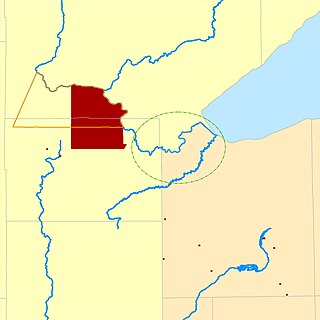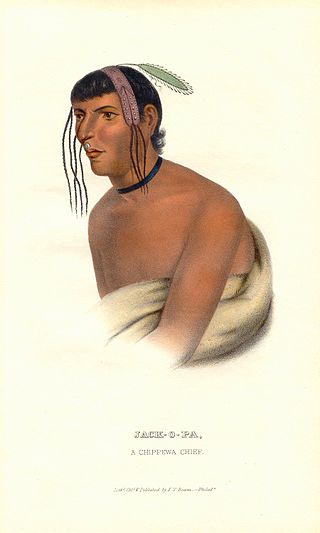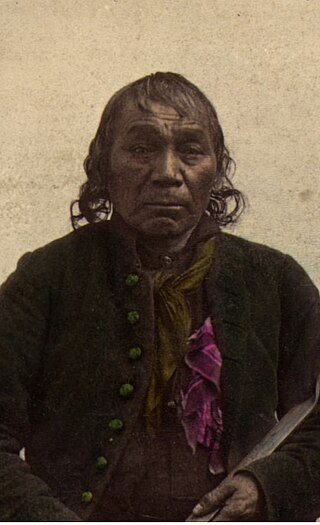1826 Treaty of Fond du Lac
The first treaty of Fond du Lac was signed by Lewis Cass and Thomas L. McKenney for the United States and representatives of the Ojibwe of Lake Superior and the Mississippi on August 5, 1826, proclaimed on February 7, 1827, and codified in the United States Statutes at Large as 7 Stat. 290. The Ojibwe chiefs who were not in attendance to the First Treaty of Prairie du Chien agreed to its adhesion. The Ojibwe Nations granted to the United States the rights to minerals exploration and mining within Ojibwe lands located north of the Prairie du Chien Line. Provisions were also made for the Ojibwe living about Saint Mary's River. As addenda to this treaty, arrest warrants to certain individuals living outside the jurisdiction of the United States were issued and land grants to the Métis were made.
Signatories
| # | Location | Recorded name | Name (Translation/"Alias") |
|---|---|---|---|
| 01 | St. Marys | Shin-gau-ba Was-sin | Zhingaabewasin (Image Stone) [lower-alpha 1] |
| 02 | St. Marys | She-wau-be-ke-toan | Zhiiwaabikitoon (Jingles) |
| 03 | St. Marys | Way-ish-kee | |
| 04 | St. Marys | Shee-gud | Miishigaad (Hairy Leg) |
| 05 | St. Croix Band | Pee-zhick-ee | Bizhiki (Buffalo) |
| 06 | St. Croix Band | No-den | Noodin (Wind) [lower-alpha 2] |
| 07 | St. Croix Band | Na-gwun-a-bee | Negwanebi ("Tallest" [Quill]feather) |
| 08 | St. Croix Band | Kau-be-map-pa | Gaa-biimabi (He that sits to the side/"Wet Mouth") |
| 09 | St. Croix Band | Chau-co-pee | Zhaagobe (Six) ("Jack-O-Pa") |
| 10 | St. Croix Band | Jau-beance | [A]yaabens (Little Buck) |
| 11 | St. Croix Band | Ul-tau-wau [lower-alpha 3] | Odaawaa (Trader/"Ottawa") |
| 12 | St. Croix Band | My-een-gun-sheens | Ma'iinganzhiins (Little Bad-Wolf) |
| 13 | St. Croix Band | Moa-so-mo-nee | Máza-máni (Ironwalker) [lower-alpha 4] |
| 14 | St. Croix Band | Muck-u-day peenaas | Makade-bines (Black Bird) |
| 15 | St. Croix Band | Shee-wee-tau-gun | Zhiiwitaagan (Salt) |
| 16 | La Pointe Band | Pee-xhick-ee | Bizhiki (Buffalo) |
| 17 | La Pointe Band | Kee-mee-wun | Gimiwan (Rain) |
| 18 | La Pointe Band | Kau-bu-zo-way | |
| 19 | La Pointe Band | Wy-au-wee-nind | Wayaa-wiinind (One Who Will Be Named) |
| 20 | La Pointe Band | Pee-kwauk-wo-to-an-se-kay | Bikwaakodowaanzige (Ball of Dye) |
| 21 | Lac Courte Oreilles Band | Pay-baum-ik-o-way | |
| 22 | Lac du Flambeau Band | Gitshee Waubeeshaans | Gichi-waabizhesh (Big Marten) |
| 23 | Lac du Flambeau Band | Moa-zo-nee | Moozonii (Moose People) |
| 24 | Lac du Flambeau Band | Git-shee Mi-gee-zee | Gichi-migizi (Great Eagle) |
| 25 | Lac du Flambeau Band | Mi-zhau-quot | Mizhakwad (Clear Sky) |
| 26 | Ontonagon | Keesh-kee-to-wug | Giishkitawag (Cut Ear) |
| 27 | Ontonagon | Pee-nay-see | Binesi (Bird) |
| 28 | Ontonagon | Mau-tau-gu-mee | Madaagami (Choppy Waters) |
| 29 | Ontonagon | Kwee-wee-zais-ish | Gwiiwizhenzhish (Bad Boy) |
| 30 | Vermilion Lake | At-tick-o-ans | Adikoons (Little Elk) |
| 31 | Vermilion Lake | Gy-ut-shee-in-i-nee | Gayaachiinh-inini (Small Man) |
| 32 | Vermilion Lake | Jauk-way | [O]jaakwe (Has a Soul) |
| 33 | Vermilion Lake | Mad-wag-ku-na-gee-zhig-waab | |
| 34 | Vermilion Lake | Jau-ko-gee-zhig-waish-kun | Jaagogiizhigweshkang (Treads Against the Sky) |
| 35 | Vermilion Lake | Nee-zbo-day [lower-alpha 5] | Niizhoodenh (Twin) |
| 36 | Vermilion Lake | Nun-do-chee-ais | |
| 37 | Vermilion Lake | O-gee-mau-gee-gid | |
| 38 | Vermilion Lake | An-nee-mee-kees | Animikiins (Little Thunder) |
| 39 | Ontonagon | Kau-waish-kung | Gaaweshkaang (Moves Homeward) |
| 40 | Ontonagon | Mau-tau-gu-mee | Madaagami (Choppy Waters) |
| 41 | Snake River | Way-mit-te-goash | Wemitigoozh (Frenchman) |
| 42 | Snake River | Isk-quag-wun-aa-bee | Ishkwaagwanebi (End [Quill]feather) |
| 43 | Snake River | Mee-gwun-aus | Miigwanens (Little Feather) |
| 44 | Lac du Flambeau Band | Pa-moos-say | Bemose (Walking) |
| 45 | Lac du Flambeau Band | May-tau-koos-ee-gay | Metaakozige ([Smokes] Pure Tobacco) [lower-alpha 6] |
| 46 | Rainy Lake | Aa-nub-kum-ig-ish-kunk [lower-alpha 7] | Aanakamigishkaang ([Traces of] Foot Prints [upon the Ground]) |
| 47 | Sandy Lake Band | O-sau-mem-i-kee | Ozaawinimikii (Yellow Thunder) |
| 48 | Sandy Lake Band | Git-shee Way-mir-tee-go-ost [lower-alpha 8] | Gichi-wemitigoozh (Big Frenchman) |
| 49 | Sandy Lake Band | Paa-shu-nin-leel [lower-alpha 9] | Beshaa-inini (Striped-man) |
| 50 | Sandy Lake Band | Wau-zhus-ko-kok | Wazhashkokon (Muskrat's Liver) |
| 51 | Sandy Lake Band | Nit-um-o-gau-bow-ee | Netamigaabawi (Stands First) |
| 52 | Sandy Lake Band | Wat-tap | Wadab (Spunk) |
| 53 | Fond du Lac Band | Shin-goop | Zhingob (Spruce) |
| 54 | Fond du Lac Band | Mon-e-to-gee-zi-so-ans | Manidoo-giiziswens (Little Sun-Spirit) |
| 55 | Fond du Lac Band | Mong-a-zid | Maangozid (Loon's Foot) |
| 56 | Fond du Lac Band | Ma-ne-to-gee-zhig | Manidoo-giizhig (Sky Spirit) |
| 57 | Fond du Lac Band | O-jau-nee-mau-son | |
| 58 | Fond du Lac Band | Mis-kwau-tais | Miskwaades ([Painted] Turtle) |
| 59 | Fond du Lac Band | Nau-bu-nay-ger-zhig | Nabane-giizhig (One-side of the Sky) |
| 60 | Fond du Lac Band | Un-nau-wau-bun-daun | Aanawaabandan (Look in Despair) |
| 61 | Fond du Lac Band | Pau-tau-bay | |
| 62 | Fond du Lac Band | Mi-gee-see | Migizi (Eagle) |
| 63 | Ontonagon | Waub-ish-kee-pee-naas | Waabishki-bines (White Bird) |
| 64 | Ontonagon | Tweesh-tweesh-kee-way | Jwiichwiishkiwenh (Plover) |
| 65 | Ontonagon | Kun-de-kund | Okandikan (Bouy) |
| 66 | Ontonagon | O-guh-bay-au-nuh-quot-way-bee | Ogabe-aanakwadwebi (Sit Upon The Cloud's End) |
| 67 | Ontonagon | Pay-bau-mau-sing | Bebaamaasing (Blown About) |
| 68 | Ontonagon | Keesh-kee-mun | Giishkimon (Whetstone/"Sharpened Knife") |
| 69 | Crow Wing River | Mau-gu-gau-bo-wie | |
| 70 | Crow Wing River | Pu-dud | Pítad (Muskrat's Liver) [lower-alpha 10] |
| 71 | Crow Wing River | Naug-du-nosh [lower-alpha 11] | Naaganaash (Leads by the Wind) |
| 72 | Crow Wing River | O-zhus-kuck-oen | Wazhashkokon (Muskrat's Liver) |
| 73 | Crow Wing River | Waub-o-gee | Waabojiig (White Fisher) |
| 74 | Crow Wing River | Saw-ba-nosh | |
| 75 | Crow Wing River | Kee-way-den | Giiwedin (North [Wind]) |
| 76 | Crow Wing River | Git-shee-mee-win-i-nee | |
| 77 | Crow Wing River | Wy-nu-nee | |
| 78 | Crow Wing River | O-bu-mau-gee-zhig | |
| 79 | Crow Wing River | Pay-bou-mid-gee-wung | Bebaamijiwang (Meandering Current) |
| 80 | Crow Wing River | Mau-gee-gau-bou | Maajigaabawi (Starts to Stand/"Stepping Ahead") |
| 81 | Crow Wing River | Pay-bau-mo-gee-zhig | Bebaamogiizhig (Sky Rambling) |
| 82 | Crow Wing River | Kau-be-map-pa | Gaa-bimabi (He that sits to the side) |
| 83 | Crow Wing River | Way-mit-te-goa-zhu | Wemitigoozhi (Frenchman) |
| 84 | Crow Wing River | On-ju-pe-naas | Aanji-bines (Changing Bird) |
| 85 | Crow Wing River | Mad-way-os-sin | Madwewasin (Hears Stones) |














